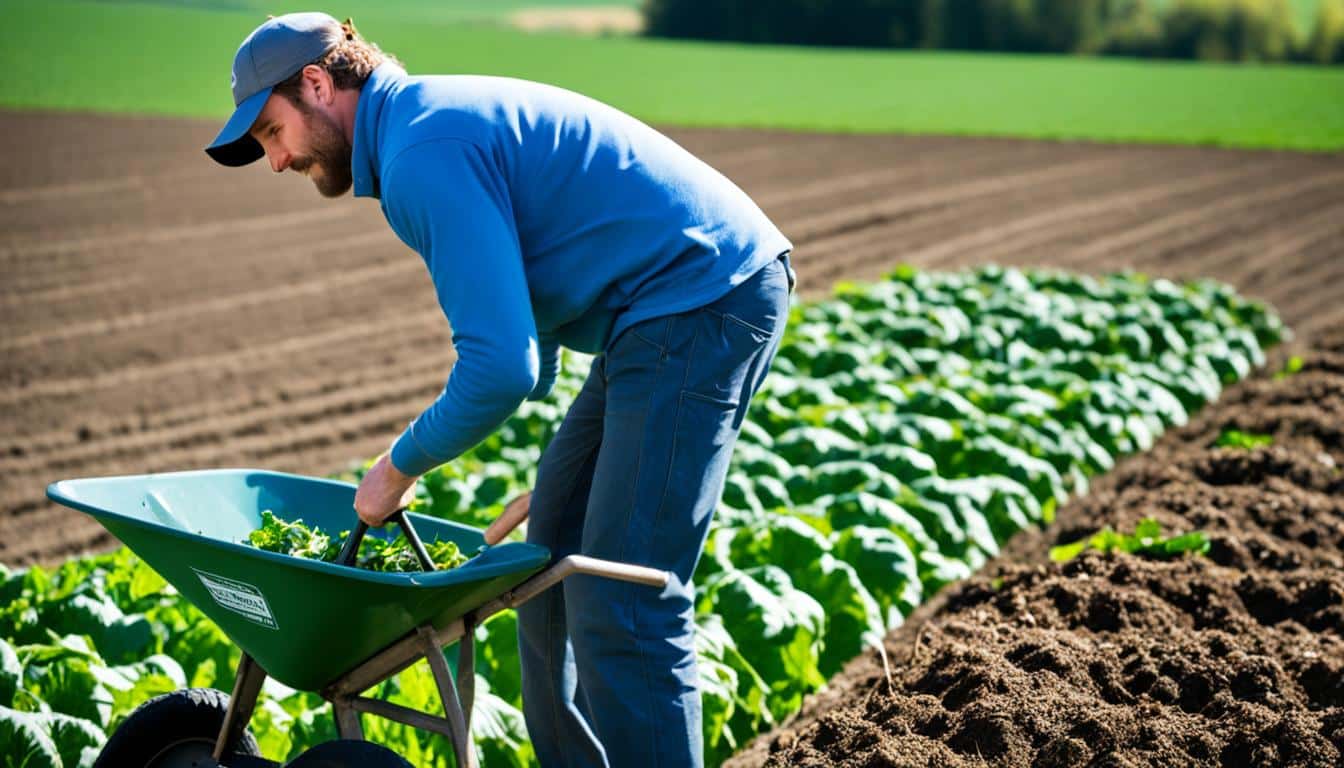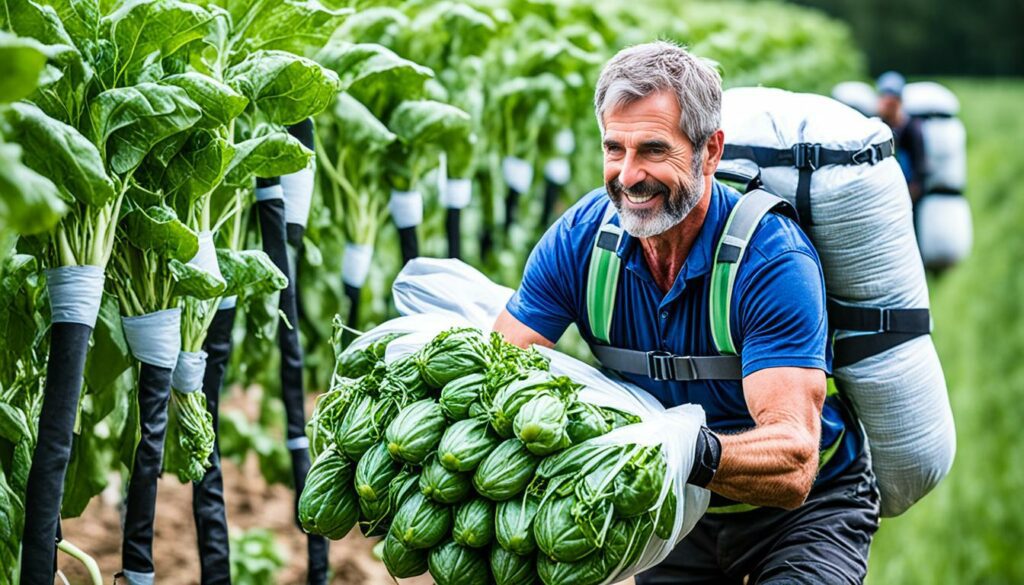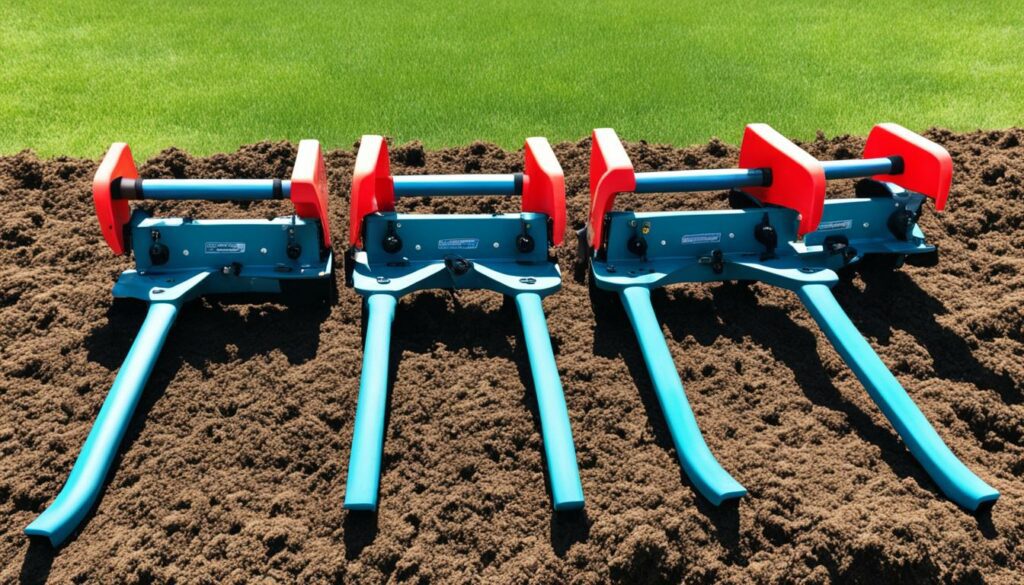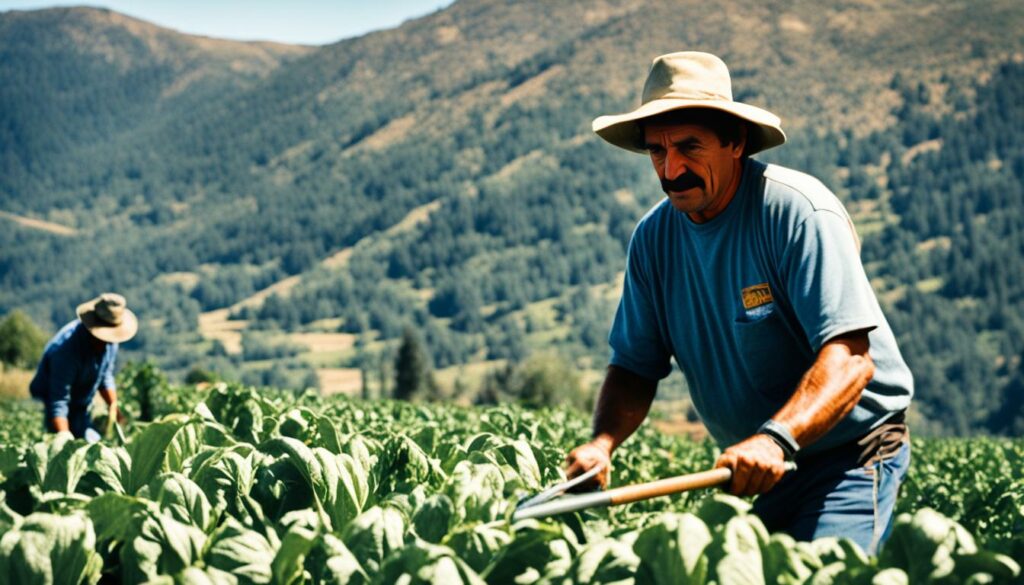Menu

Farm workers often suffer from back pain and arm issues. The National Institute for Occupational Safety and Health highlighted these problems in 2001. They showed the urgent need for better ergonomic practices in farm work. The strains from farm work can lower worker output and harm their health and finances over time.
Ergonomics is about making tools fit better to reduce tiredness and pain. It’s key for tackling these common health problems on farms. Adjusting tools and workspaces, and starting with better habits from the beginning, can cut the chances of getting hurt. Early focus on these practices can keep workers healthy, improve their posture, and make their work areas safer.
Farm labour ergonomics focuses on making workspaces and tools suitable for the user. This lowers the chance of getting hurt and makes work more efficient. It’s all about making sure the job doesn’t hurt the worker over time.
Farm labour ergonomics is about designing things to help work better and safer. This is crucial because not doing this causes a lot of pain. Farm workers often complain of back pain and pains in their arms and hands. Doing ergonomics right can make a big difference in how they feel and how much work they can do.
Farm workers often suffer from backaches, and shoulder, arm, and hand pain. These issues come from tough tasks or uncomfortable positions that happen a lot. If this isn’t fixed, it can lead to serious health problems. This would hurt the farm’s ability to work and cost a lot of money.
Starting ergonomics early helps prevent injuries in farm workers. It includes things like making tools easier to hold and fixing workspaces for better posture. Changing tools and how they’re used can help a lot. It cuts down the chance of getting hurt from hard jobs.
A third of the injuries that cause farm workers to miss work are sprains and strains, whilst a quarter are back injuries.
Ergonomic tools make farm work easier and safer. They reduce strain on the body and make tasks more efficient. This helps farm labourers stay healthy and work better.
These tools are designed to lessen physical stress. They have features like comfortable grips. The space between the thumb and forefinger is kept under 3/8 inches. This minimises the risk of musculoskeletal disorders.Ergonomic best practices for farm labour also include tools with padded handles. They are made from lightweight materials.
Ergonomic tools bring many benefits. Research shows that reducing a tool’s weight by 11 pounds can lower pain by 20%. This doesn’t reduce how much work gets done.These tools help workers maintain better posture. They decrease the effort needed and cut down on repeated movements. This is key to preventing injuries. A large portion of farm injuries are sprains and strains, which affect the back a lot. So, using ergonomic tools is vital for making the job safer.
Handle adaptations like foam pool noodles can make tools more comfortable. They help reduce tiredness. Tools with padded handles and those made from light materials are also great examples. They lessen the load on the body.In California, adaptations like these have cut down back injuries. This has saved a significant amount of money in workers’ compensation. Ergonomic tools truly make a difference in farmers’ lives.
To sum up, ergonomic tools are a game-changer for farm workers. They lower the chance of getting hurt and boost work efficiency. This means a healthier and more effective farming workforce.
Making sure that work areas are designed with ergonomics in mind is key to helping farm workers feel better and work more effectively. This involves setting work areas at the right heights and making tools easy to reach. These steps help cut down on the strain and risk of getting hurt.
The best ergonomic workspaces are those that promote good posture and require less effort. This reduces the toll on the body, which helps workers stay productive and avoid muscle problems. The ideal height for a workbench is around the worker’s hip, especially for heavy work. This keeps the body in a more relaxed position.
Experts advise keeping work surfaces at about hip height, or a bit lower, for tasks that need more effort. This setup is more stable and cuts down on back strain. Lifting things at the wrong height can lead to common back injuries in farming. These injuries cost a lot, with more than 3,000 happening each year in California alone, and pushing workers’ compensation bills over $22 million.
Having easy access to tools is crucial in farming workspaces. Essential tools should be within 17 inches of the worker to avoid overreaching and odd postures. This is key to preventing sprains, strains, and wear-related injuries often seen in farming. Storing tools between knee and shoulder height is a great way to cut down on the need to stretch or bend too much.
Using things like floor mats, which AgriSafe Network recommends, can help reduce tiredness when standing on hard surfaces. These small changes in the workspace can lead to better posture and a much safer, more productive farm.
In the agricultural sector, staying mindful of your posture is vital. It helps prevent backaches and shoulder, arm, and hand pains. These issues are often faced by farm workers. By focusing on sitting and standing straight, moving naturally, and making tasks more ergonomic, we create a safer working space.

Having a straight back helps avoid back injuries during farming tasks. It’s crucial workers bend their knees, not their waist, for lifting or carrying. Doing this protects the spine and keeps the body healthy. Around a third of farm injuries that lead to missed work are strains. Following good posture greatly cuts down on these risks.
It’s key to move naturally while working. Using smooth, natural motions helps keep the body healthy. Tasks done with too much force or in odd positions can hurt. But, by encouraging workers to move more freely and not stay stiff, we can make work safer. This also helps spread the effort across different muscles, reducing the chance of injuries.
Every job may need its own ergonomic tweaks. For example, the height of a stand-up workstation should suit the work and the worker’s size. Tools must be easy to hold, ensuring safe lifting. Also, making sure seats are available and items are close by helps cut down on back and leg strain.
It’s vital to use safe lifting techniques to lower the risk of injuries at work. By using the right methods, the chance of getting hurt decreases a lot. This is especially true for farm workers who often lift heavy items.
Always get as close to the load as you can before lifting. This means the object is closer to you and easier to carry without strain. Remember to bend your knees and keep your back straight when lifting from the ground.
It’s also important to tighten your stomach muscles while lifting. This keeps your back safe. Don’t forget to breathe out while you lift to avoid putting too much pressure on your chest.
Taking your time to lift and moving smoothly reduces the dangers. If you need to lift something high, consider using a ladder or a machine. This way, you won’t have to strain too much.
After lifting something safely, it’s just as key to carry it well. For heavy loads, over 50 pounds, the risk of injury goes up. Using things like carts makes it easier and less likely to get hurt.
Always keep the load close to your body while moving. And try not to twist; it can hurt your back.
Using the right bags and grips can make carrying safer and more comfortable. Ergonomic totes and handles lessen the pain from carrying heavy things. They give your hands a better grip and reduce how tired you get.
By sticking to these safe lifting techniques, farm workers can cut down on the dangers of their job. This makes for a healthier and happier workplace.
In farming, using assistive technologies can greatly lessen physical strain. This boost both productivity and the health of the farm workers. For instance, battery-operated tools like pruners and shears make tasks easier. They cut down on muscle work, which helps avoid injuries from repetitive movements.

Battery-powered tools are key in cutting down the tiredness from hard work. They include items like electric shears and pruners. These tools speed up work and reduce the need for long periods of gripping. This can prevent problems like carpal tunnel syndrome. They also make it less hard to use tools, stopping the back and arm pain many farmers face.
Scooter wagons are another important type of assistive tech. They lower the effort needed to move items around the farm. This means less heavy lifting and walking, easing pressure on the body. They are a great example of how technology can meet the needs of farmers while keeping them healthy.
Looking at the broader benefits of assistive technologies, we can’t overlook AgrAbility. They had helped more than 200 farmers by 2023 in 21 states. Their help involves checking the farm and suggesting the best tools and tactics. This practical approach shows that using the right tools can make a farm safer and more productive.
It’s vital to have regular rest breaks on the farm. They help avoid worker tiredness and keep the team safe from injuries. Taking breaks boosts how much work gets done and makes workers feel better. It’s not just for comfort. Rest and changing tasks keep muscles from being overused and helps people work better.
Farm workers must take regular breaks. Without enough rest, they can get very tired and even hurt. Taking breaks stops muscles and joints from getting too worn out. This can help avoid problems like carpal tunnel syndrome, a hand condition made worse by doing the same movements over and over.
Changing tasks helps everyone on the farm stay healthy and do more work. It stops the same muscles from being used too much, which can lead to pain. By doing different jobs, everyone uses their muscles in different ways. This prevents a lot of the common injuries farm workers face.
Stretching and changing sides often are great ways to stay energised. Stretching keeps your muscles flexible and reduces the soreness from doing the same thing all day. When you switch sides, it gives some muscles a break while you use others. This means everyone stays strong and active on the farm.
When we look at tools and how we work, we need to think about a few things. Comfort, how well they work, and safety matter a lot. We want workers to be happy, work well, and not get hurt.

Checking tools in farming means we should look at a few key points. We check how easy they are to change, use, and if they fit different people. This is to stop muscle and bone problems from happening. We also look at things like handle size, how the weight is shared, and what the handle is made of. This helps make sure using the tool won’t hurt the hands, shoulders, or back.
Some easy changes can help a lot. For example, making grips fit better, adding soft parts to ease doing things over and over, or making tools longer so no one has to bend too much. Doing these things can mean fewer back pains and less strain. In California farming, making tools better, so they fit the body well, has saved a lot of money. More than $22 million in one year alone, by preventing back injuries. It also makes working safer.
Thinking about when changes worked well can show us why we should do it. For example, changing tools to have better grips and be less heavy made workers’ pains less in California’s fruit gardens. Over there, about 150 people at a training session talked about ladder and back safety. This made fewer people get hurt and work better. Stories like these show how important it is to make work tools fit well. And how it can help others too.
| Ergonomic Criteria | Before Modification | After Modification |
|---|---|---|
| Tool Handle Comfort | Poor, causing calluses | Improved, with padding added |
| Weight of Tool | Heavy, causing fatigue | Lighter, reducing muscle strain |
| Grip Size | Too large or small | Adjusted to fit user hands |
| Injury Incidence | High, frequent back and arm pains | Lower, significant reduction in reported injuries |
| Productivity | Hindered, due to discomfort | Enhanced, with less time lost to injury |
Farm workers need to look after their hands and wrists. Long periods of gripping can cause carpal tunnel syndrome. This affects how well they can work and their health. By making a few changes, like using ergonomic tools, we can prevent these problems. This helps to look after their hands and wrists.
Carpal tunnel syndrome happens when hands and wrists do the same movements over and over. Farmers often face this issue. It causes pain and a feeling of pins and needles in the hand. By using tools with ergonomic handles, we can stop this syndrome from happening. These tools should be easy to grip and shaped well for the hand. This is important because hand problems are a big reason for not being able to work. So, it’s wise to use tools that make work safer.
Choosing the right design and material for tool handles is crucial. They need to be comfy and easy to hold without slipping. Tools should have padding to reduce vibrations and pressure on the hands. Handles must also be the right size to avoid strange hand positions. This stops hand issues like carpal tunnel syndrome from starting.
There are many agricultural tools that are good for hands. These include tools with soft, easy-to-hold handles. They also have grips that don’t let hands slip off. Tools that keep the wrist in a natural position share the work better across the hand and wrist. For example, pruning shears with special designs make work easier and keep workers safe from injuries.
| Tool | Ergonomic Feature | Benefit |
|---|---|---|
| Secateurs | Padded, non-slip grip | Reduces hand fatigue and prevents slipping |
| Spade | Cushioned handle | Absorbs vibrations, reducing hand and wrist strain |
| Pruners | Adjustable handle size | Ensures a natural wrist position |
Helping farm workers with good tools and stools is key. Bending and stooping a lot can cause back pain. Longer tool handles and stools make work easier and safer.

Tools with longer handles help cut down on bending. They allow workers to stand more upright. This reduces back pain, especially when lifting or doing things over and over.
Providing stools helps workers avoid stooping. This lets them work near the ground without hurting their backs. It also means they can work longer without taking breaks because of pain.
Longer tools and stools are not the only tricks. We can also change the job or workspace. For example, picking crops that grow higher up means less stooping. These steps can cut down on worker injuries.
| Problem | Solution | Benefit |
|---|---|---|
| Backaches and pain from stooping | Increased tool handle length | Reduces the need to bend, alleviating back strain |
| Discomfort from prolonged kneeling | Using stools | Allows seated work, reducing lower back strain |
| Frequent bending and heavy lifting | Other modifications (e.g., work environment design) | Minimises bending and improves ergonomic conditions |
Improving tools and adding stools helps farm workers a lot. These changes, and rethinking work areas, make farming safer and better. It’s about making life healthier for those who work the land.
Repetitive actions often lead to health issues in farmers. It’s important to find these tasks and lessen their impact. This way, we can keep farm workers healthy and safe for longer.
Investigating repetitive tasks is key. We look for actions that use the same muscles over and over. This can tire muscles and cause injuries. Common signs are a sore back and pain in arms and hands, a study found. Knowing this helps us stop the harm.
Changing tasks often keeps workers healthy. We mix jobs that use different parts of the body. For example, we swap picking crops with office work. This gives muscles a break.
Rearranging work can save workers from overdoing it. We plan jobs that vary in effort to balance the body’s strain. This is good for their health, making injuries less likely.
Analyzing and changing farm tasks can make the job better. This approach protects workers’ health and boosts their happiness and output over time.
In farming, it’s crucial to use top ergonomic practices. These help reduce tiredness, keep workers safe, and maintain high productivity. Such practices are not just a rule to follow; they’re essential for the overall well-being of every worker.

For less tiredness among farm workers, the environment and tools must be designed smartly. Many workers suffer from backaches and arm pains. Fixing this issue with the right tools is key. Tools should be between 1-3/8” to 2-1/8” in handle diameter to cut down on effort.
Workstations should also be at the perfect height. For men, that’s 40″ to 43″. For women, 37″ to 39″ is best. This reduces the stress on their bodies.
Keeping work both safe and productive is at the heart of ergonomics. It’s advised to keep items workers use often close, within 17 inches. This stops them from overreaching. Vehicles with seats that reduce vibrations are a must. In California, over $22 million is spent yearly on back injuries in agriculture. This shows the huge impact of these safety steps.
Using tools like dollies or utility carts also helps. They make lifting easier and safer, cutting injury risks.
Investment in ergonomics pays off with better health for workers. Work-related disorders are a leading cause of disability. Ergonomic processes can greatly lower this risk.
By making work simpler, the chance of chronic health issues lowers. This benefits both the workers and the farm’s bottom line. Starting ergonomic training early is crucial for everyone’s health and to avoid lost workdays.
| Issue | Impact | Ergonomic Solution |
|---|---|---|
| Backaches and pains | Leading cause of disability | Proper workstation heights, tool handle adjustments |
| Musculoskeletal disorders | Primary cause of disability | Redesigning tools and work processes |
| Fatigue from prolonged standing | Chronic discomfort | Using floor mats |
| Repetitive strain injuries | Carpal tunnel syndrome | Reducing weight of tools, using handles |
Making sure loads are handled safely on farms is essential for the workers’ health and safety. By following safe load handling guidelines and using ergonomic methods, we can cut down on the risk of getting hurt from farm work.
Keeping loads near you is key for safe handling. This method uses your core strength and makes you more stable, lessening damage to your back. It’s advised to keep work items about 17 inches away from your body to lower the risk of getting hurt.
Heavy lifting can cause back pain and pain in the shoulders, arms, and hands for those on the farm. So, following this advice is crucial.
Overloading in farm work often results in bad injuries. About a third of missed work injuries in farms are from sprains and strains, mostly affecting the back. To prevent this, only lift what you can handle comfortably and keep loads from the ground to shoulder level.
In California, over 3,000 back injuries among farmworkers can cost more than $22 million a year. This shows how much impact overloading can have financially.
Dollies, conveyor belts, and forklifts are crucial for safer lifting. They help move heavy stuff without as much risk. Using vehicles with special seats to reduce vibration is also smart. This mixes machines with manual work, lowering the chance of muscle and joint problems, which often disable people in their work prime.
By following these safe load handling guidelines and using mechanical aids for ergonomics, farm workers’ health and safety get a big boost. A combination of smart lifting, tools, and keeping loads near can make farm work safer. This supports a lasting, safe culture in agriculture.
Using ergonomic considerations in various farm tasks helps a lot. It makes farm work easier, cuts down on injuries, and keeps workers healthier. Each job on the farm, planting, weeding, harvesting, and carrying things, needs its own clever ergonomic solutions.
When planting or weeding, long-handled tools are a must. They cut down on bending over, which lessens backache risks. Bringing sit-stand stools into the mix helps too. They make tasks easier on the legs and hips.
Ergonomic tools and containers matter a lot for harvesting and carrying things. Lighter loads and using totes with grips can make a big difference. This advice comes from a study by Meyers and his team in 2006. It proves that good designs for tools and containers boost comfort and keep work flowing.

Thinking about tool design and workspace setup is key for maintenance jobs. Tools should have handles that most hands find easy to grab, about 1-3/4 inches wide. The right workbench heights, between 36 to 39 inches for heavy work, stop people from straining too much. This way, jobs get done without risking injury.
Adding ergonomic adjustments on farms is a smart move. It can drop the number of muscle and joint problems workers face. It’s suggested by the National Institute for Occupational Safety and Health to place main tools within 17 inches. This helps keep a good work pace and lowers the chance of doing the same motion over and over. These changes make farms safer and work run smoother.
Focusing on the right ergonomic details for each farm job is crucial. Even small tweaks, like using better tools for planting, make a big difference. They boost the health and job satisfaction of everyone working on the farm.
It’s vital to use ergonomic methods in farming, as it’s the second most dangerous job in terms of sickness and injury. Back pain and other muscle issues are common for farm workers. They cause a big part of the illnesses workers face.
Ergonomic changes can really help reduce pain felt by workers. Simple steps can make a big difference. For example, using smaller containers for picking grapes makes the job easier. Also, machines that cut crops with little effort help workers with disabilities.
Giving workers breaks from heavy tasks is important. It lets them relax a bit and reduces the chances of getting hurt. Compared to jobs like construction, farming has more injury risks. This is why changing how work is done, like using better tools, is so critical.
Improving how tasks are carried out helps everyone. It makes the work safer and more efficient. By looking after the well-being of farm workers, we secure the future of agriculture. This ensures a strong farming sector that can last.
For farm work, it’s key to use tools easing physical stress. Workstations should aid good posture. Moreover, safe lifting methods are important, as are taking breaks and switching tasks often to avoid injuries.
Signs like backaches or sore arms signal poor ergonomics. Spotting repetitive or awkward movements shows where work can be made easier and safer.
Ergonomic tools help cut down on pain and boost work output. They lower the chance of getting hurt, like with carpal tunnel syndrome. Plus, they make work more comfortable.
Making your workspace ergonomic is simple. You need to set the best bench heights and keep tools close by. Using anti-fatigue mats can also help reduce the strain of standing a lot.
It’s key to keep your back straight and bend at the knees. Mixing up your movements and sides you work on stops injuries from happening over and over.
For lifting, aim for loads between waist and shoulder height. Always keep the load near your body, and use totes that are easy to hold. These steps cut down on risks of back injuries.
Assistive gear, like battery tools, lessens muscle wear and enhances work. They are a smart choice for keeping your health in check long term.
Rest breaks are vital for preventing tiredness and injuries. By mixing up tasks and stretching, you help your muscles stay strong and avoid getting hurt.
To check if tools and ways of working are safe, focus on comfort and effective use. Changing how tools are held or adding soft parts can make a big difference. Reviews help make jobs easier and healthier.
Avoid hand and wrist issues by using right-sized, comfy tools. Look for tools that have soft parts and grips that prevent slipping. They will be easier on your hands.
To ease bending, try tools with long handles. Using stools or adjusting work areas to need less bending helps too. These changes reduce back strain and make the job site safer.
Keep an eye out for tasks done again and again that might harm your health. Break these up with different jobs, rotate who does them, and make sure there’s time to rest.
The best way to fight fatigue is to design your workspace right and use the best tools. Changingsome ways you do things can reduce how likely you are to get hurt. And take breaks regularly to stay fresh and healthy.
Handle loads carefully, by keeping them close and not carrying too much. Mechanical help, like dollies or forklifts, makes moving heavy stuff easier and safer.
For planting or weeding, use tools with long handles and sit-stand stools. This helps cut down on back aches. When you’re harvesting or moving crops, ergonomic tools make lifting easier. And for fixing things, always have proper tools and set up a safe workspace.